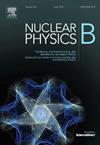Gravitational lensing and shadows of dilatonic black holes in dilaton-massive gravity
IF 2.8
3区 物理与天体物理
Q2 PHYSICS, PARTICLES & FIELDS
引用次数: 0
Abstract
This paper presents optical and astrophysical aspects of charged dilatonic black holes within the framework of dilaton-massive gravity, a promising extension of General Relativity motivated by low-energy string theory. By incorporating a nonminimally coupled scalar dilaton field and massive graviton terms into the Einstein-Maxwell action, we study static, spherically symmetric black hole solutions characterized by the parameters , , and , which control the strength of scalar-gravity and massive gravity couplings. We use Gauss-Bonnet theorem to compute the weak deflection angle of light around the black hole. The results reveal that the coupling parameter intensifies light bending, while more negative values of and higher graviton masses suppress it. Extending this analysis to realistic astrophysical settings, we introduce a cold, non-magnetized plasma environment and derive the plasma-corrected deflection angle. The presence of plasma leads to chromatic dispersion, increasing the bending of light at lower frequencies, and amplifying the influence of dilaton-massive gravity on lensing observables. Next, we examine the black hole's shadow by numerically solving for the photon sphere and evaluating the shadow radius. Our findings demonstrate that larger values of and decrease the shadow size due to increased spacetime curvature, whereas increasing expands it by lowering the gravitational potential. These effects are visualized through shadow images in celestial coordinates, clearly illustrating how modified gravity alters the observable structure of black holes.
引力透镜效应和膨胀质量引力中膨胀黑洞的阴影
本文介绍了在膨胀-质量引力框架下带电扩张黑洞的光学和天体物理方面,膨胀-质量引力是由低能弦理论驱动的广义相对论的一个有希望的扩展。通过将非最小耦合标量膨胀场和质量引力子项纳入爱因斯坦-麦克斯韦作用,我们研究了由参数c1、c2和m0表征的静态球对称黑洞解,这些参数控制着标量引力和质量引力耦合的强度。利用高斯-博内定理计算了黑洞周围光的弱偏转角。结果表明,耦合参数c1增强了光弯曲,而c2的负值越大和引力子质量m0越高则会抑制光弯曲。将这一分析扩展到现实的天体物理环境中,我们引入了一个冷的、非磁化的等离子体环境,并推导了等离子体修正的偏转角。等离子体的存在导致色散,增加了低频光的弯曲,并放大了膨胀质量引力对透镜观测的影响。接下来,我们通过数值求解光子球和计算阴影半径来检查黑洞的阴影。我们的研究结果表明,较大的c1和m0值由于时空曲率的增加而减小了阴影的大小,而增加的c2通过降低引力势而使阴影扩大。这些影响通过天体坐标的阴影图像可视化,清楚地说明了改变的引力如何改变黑洞的可观测结构。
本文章由计算机程序翻译,如有差异,请以英文原文为准。
求助全文
约1分钟内获得全文
求助全文
来源期刊

Nuclear Physics B
物理-物理:粒子与场物理
CiteScore
5.50
自引率
7.10%
发文量
302
审稿时长
1 months
期刊介绍:
Nuclear Physics B focuses on the domain of high energy physics, quantum field theory, statistical systems, and mathematical physics, and includes four main sections: high energy physics - phenomenology, high energy physics - theory, high energy physics - experiment, and quantum field theory, statistical systems, and mathematical physics. The emphasis is on original research papers (Frontiers Articles or Full Length Articles), but Review Articles are also welcome.
 求助内容:
求助内容: 应助结果提醒方式:
应助结果提醒方式:


